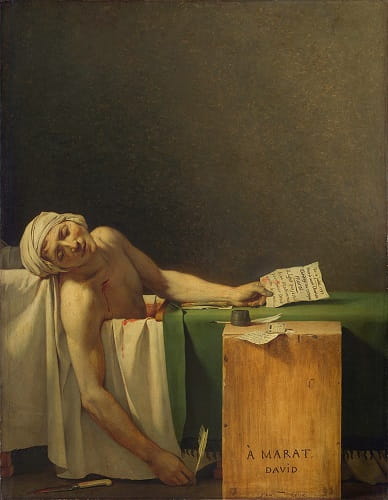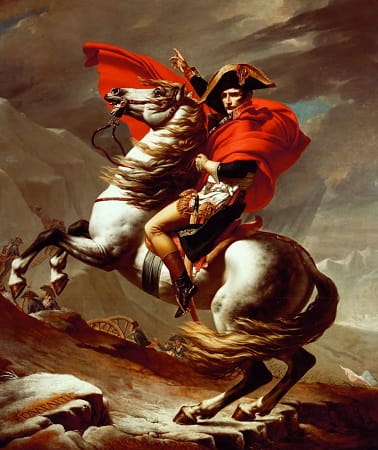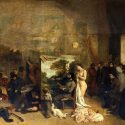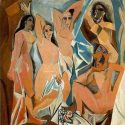10 Iconic Neoclassical Paintings
Neoclassical art, a movement that emerged in the late 18th century and extended into the 19th century, is a captivating bridge between the grandeur of classical antiquity and the tumultuous modern world. This artistic era, characterized by its revival of classical themes, ideals, and aesthetics, has left an indelible mark on the world of painting. In this journey through Neoclassicism, we will explore the elegance, precision, and intellectual depth that define this art movement by introducing you to 10 Famous Neoclassical Paintings.
Neoclassicism was not merely an aesthetic choice; it was a reflection of the social and political upheavals of its time. Artists sought to emulate the grace and harmony of ancient Greece and Rome while simultaneously engaging with contemporary issues. This fusion of historical reverence and modern relevance resulted in a body of work that resonates with art enthusiasts and historians alike.
Our curated selection of paintings goes beyond the surface, inviting you to delve into the narratives, symbolism, and emotional impact that these masterpieces hold. From mythological sagas to pivotal moments in history, each painting offers a unique lens through which to view the past, present, and timeless artistic expression.
Join us on this artistic journey as we uncover 10 Neoclassical paintings that have stood the test of time, providing insights into the artists’ genius and the enduring allure of Neoclassical artistry.
Whether you’re an art aficionado or a curious explorer of the art world, this exploration of Neoclassical paintings promises to deepen your appreciation for the genre and its enduring legacy.
10 Neoclassical Paintings You Should Know
10- The Death of Marat, 1793 by Jacques-Louis David
A poignant portrayal of the revolutionary figure Jean-Paul Marat, this painting captures the dramatic intensity of a key moment in the French Revolution.

The Death of Marat, 1793 by Jacques-Louis David – 10 Famous Neoclassical Paintings.
9- The Valpinçon Bather, 1808 by Jean Auguste Dominique Ingres
Jean Auguste Dominique Ingres’s masterful work showcases a graceful and enigmatic study of the female form, exemplifying Neoclassical ideals of beauty and form.
“The Valpinçon Bather” by Jean-Auguste-Dominique Ingres is a female nude in a chaste pose. Her neck and the curves of her back and legs are accentuated by the curves in the green draperies.

The Valpinçon Bather, 1808 by Jean Auguste Dominique Ingres – The Louvre Museum – 10 Neoclassical Masterpieces You Should Know.
With the white linen in front of her and the folds of the bedsheets, this painting lacks the overt sexuality of other Ingres paintings.
Ingres has masterfully depicted a calm and measured sensuality which is a masterpiece of harmony and light. Ingres returned to the form of this figure several times in his life.
Most famously in “The Turkish Bath” of 1863, the central character in the foreground plays the mandolin which echoes in rhythm and tone this figure.
The Turkish Bath was the last of his Orientalist paintings of the female nude and was finished when Ingres was 83 years old.
8- The Intervention of the Sabine Women, 1799 by Jacques-Louis David
This monumental painting depicts a legendary episode from Roman history, offering a compelling narrative and a display of Neoclassical precision and grandeur.

The Intervention of the Sabine Women, 1799 by Jacques-Louis David – 10 Iconic Neoclassical Paintings.
The Intervention of the Sabine Women is a 1799 painting by the French painter Jacques-Louis David, showing a legendary episode following the abduction of the Sabine women by the founding generation of Rome.
Work on the painting commenced in 1796 after his estranged wife visited him in jail. He conceived the idea of telling the story, to honor his wife, with the theme being love prevailing over conflict and the protection of children.
7- The Death of General Wolfe, 1776-1806 by Benjamin West
This historic painting captures a pivotal moment during the American Revolutionary War.
General James Wolfe, the British commander, lies mortally wounded on the Plains of Abraham after his victory at the Battle of Quebec.

The Death of General Wolfe, 1776-1806 by Benjamin West – 10 Neoclassical Masterpieces You Should Know.
The artwork symbolizes the price of victory and the sacrifices made for a nation’s independence.
6- Napoleon Crossing the Alps, 1801 by Jacques-Louis David
This iconic painting captures the indomitable spirit of Napoleon Bonaparte as he embarks on his daring journey through the treacherous Alps.
David’s portrayal of Napoleon, astride a rearing horse and dressed in a dramatic red cloak, exudes power and determination.

Napoleon Crossing the Alps, 1801 by Jacques-Louis David – Neoclassicism.
The tumultuous terrain and atmospheric effects add to the dramatic impact of the composition. This painting is not just a depiction of a historical event; it is a symbol of leadership, ambition, and the audacity to defy nature’s challenges.
5- The Coronation of Napoleon, 1805-1807 by Jacques-Louis David
This monumental painting captures a defining moment in European history—the coronation of Napoleon Bonaparte as Emperor of the French in 1804.

The Coronation of Napoleon, 1805-1807 by Jacques-Louis David – 10 Neoclassical Masterpieces You Should Know.
Jacques-Louis David‘s meticulous attention to detail and historical accuracy make this artwork a masterful representation of the event. It showcases Napoleon and Josephine, adorned in opulent regalia, in the grandeur of Notre Dame Cathedral in Paris.
The surrounding dignitaries and onlookers, including Pope Pius VII, add to the painting’s historical significance.
David’s portrayal not only serves as a record of the coronation but also underscores Napoleon’s ambition and desire to legitimize his rule.
The painting is a testament to the fusion of art and politics, capturing the essence of an era marked by power and spectacle.
4- Venus Induces Helen to Fall in Love with Paris, 1790 by Angelica Kauffman
The painting you mentioned, “Venus Induces Helen to Fall in Love with Paris,” is a significant work in Neoclassical art. It portrays a scene from Greek mythology where Venus, the goddess of love, is encouraging Helen of Troy to fall in love with Paris, which ultimately leads to the events of the Trojan War.
Recommended For You – Ancient Greek Gods

Venus Induces Helen to Fall in Love with Paris, 1790 by Angelica Kauffman – 10 Famous Neoclassical Paintings.
The painting depicts the moment when Venus, the goddess of love and beauty, uses her charms to persuade Helen of Troy to fall in love with Paris, a prince of Troy. According to Greek mythology, this event ultimately led to the abduction of Helen and the outbreak of the Trojan War.
“Venus Induces Helen to Fall in Love with Paris” is significant not only for its artistic merit but also because it reflects the Neoclassical fascination with classical antiquity and mythology. During the Neoclassical era, artists often turned to Greek and Roman myths for inspiration, using them to convey moral or political messages.
3- Dante and Virgil, 1850 by William-Adolphe Bouguereau
This painting depicts a scene from Dante Alighieri’s epic poem, “The Divine Comedy.”
In particular, it portrays Dante, the poem’s author and protagonist, guided through the circles of Hell by the Roman poet Virgil. They are shown descending into the abyss, encountering various sinners and tormented souls along the way.

Dante and Virgil, 1850 by William-Adolphe Bouguereau – 10 Neoclassical Masterpieces You Should Know.
“Dante and Virgil” is notable for its faithful interpretation of Dante’s literary masterpiece. Bouguereau captures the essence of Dante’s journey through the underworld, portraying the gravity and drama of the narrative.
“Dante and Virgil” is a significant work within Bouguereau’s oeuvre, showcasing his ability to bring classical and literary subjects to life through his meticulous craftsmanship.
2- The Grande Odalisque, 1814 by Jean-Auguste-Dominique Ingres
This painting portrays a reclining female nude, often referred to as an “odalisque,” a term used to describe a woman in a harem in a Middle Eastern or Turkish setting.

The Grande Odalisque, 1814 by Jean-Auguste-Dominique Ingres – Famous Neoclassical Paintings.
The subject is presented with an elongated and sensuous form, characterized by an exaggerated lengthening of the torso and the unrealistic elongation of the spine. She is draped in luxurious fabrics, adorned with jewelry, and surrounded by exotic props, creating an idealized and fantastical vision of the Orient.
“The Grande Odalisque” is a significant work in Ingres’ career and is considered a quintessential example of his style. It represents the Neoclassical fascination with exoticism, Orientalism, and the romanticized depiction of distant lands and cultures.
The elongation of the female form in this painting has often been a subject of discussion, reflecting Ingres’ penchant for idealization over realism.
1- Portrait of Madame Récamier, 1800 by Jacques-Louis David
The painting depicts Juliette Récamier (1777-1849), a prominent French socialite and beauty of her era. She is shown reclining on a classical-style sofa, dressed in a simple, diaphanous white gown.
The composition focuses on her elegant and graceful figure, her serene expression, and her contemplative gaze. The background is minimalistic, with a curtain draping behind her.

Portrait of Madame Récamier, 1800 by Jacques-Louis David – 10 Famous Neoclassical Paintings.
“Portrait of Madame Récamier” is a celebrated work for several reasons. Firstly, it exemplifies David’s mastery of portraiture within the Neoclassical style. Secondly, it portrays Juliette Récamier, a prominent figure in French society during the late 18th and early 19th centuries, known for her beauty and influential salon. The portrait became iconic for capturing her charm and elegance.
In summary, “Portrait of Madame Récamier” by Jacques-Louis David is a notable work within the Neoclassical movement, showcasing the artist’s talent for portraiture and capturing the grace and charm of Juliette Récamier, an influential figure of her time.
The portrait’s enduring appeal lies in its classical elegance and its representation of a significant personality in French society.
References:
- https://www.theartstory.org/movement/neoclassicism/
- https://artincontext.org/famous-neoclassical-paintings/
- https://joyofmuseums.com/museums/europe/france-museums/paris-museums/the-louvre/highlights-of-the-louvre/the-valpincon-bather-by-jean-auguste-dominique-ingres/
- https://en.wikipedia.org/wiki/The_Valpin%C3%A7on_Bather
- https://en.wikipedia.org/wiki/The_Intervention_of_the_Sabine_Women
- https://artsandculture.google.com/asset/the-death-of-general-wolfe/MQGJPSKUj9ySHg?hl=tr
- https://www.wikidata.org/wiki/Q16038758
- https://en.wikipedia.org/wiki/Portrait_of_Madame_R%C3%A9camier









I’m happy reading your article. I learned lots of things regarding the Neoclassical Paintings. Thank you.
Thank you.